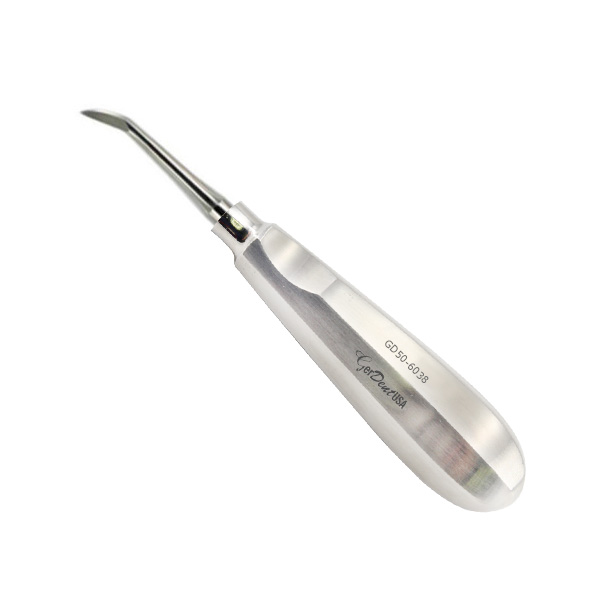

A dental elevator or tooth elevator is a specialized instrument used by dentists and oral surgeons to ease dental extractions.
This special instrument plays a very crucial role in safe tooth removal.
For instance, teeth that are fractured and impacted, with compromised root structures, among other characteristics, cannot be extracted only with forceps.
This guide will help you learn how these dental elevators are used, their types, and their uses.
Elevator dental tool works on the well-established principle of leverage to loosen a tooth from its socket in the jawbone.
The elevator acts as a fulcrum, with the bony ridge surrounding the tooth socket providing a stable base.
The dentist strategically places the elevator tip on a specific tooth root area (known as the purchase point).
The dentist creates a rocking motion by applying gentle and controlled pressure to the elevator handle.
This mild rocking movement allows the tooth to be removed without injury to tissues and surrounding bone. It separates periodontal ligament fibers that act as the tooth's anchor.
There is no one-size-fits-all approach to extracting a tooth; the same can be said for extraction elevators.
Several tooth elevators are available, all meant for particular extraction circumstances. Take a closer look at the following popular types:
As the name suggests, these elevators are used to elevate and reflect gum tissue away from the bone during tooth extraction, providing transparent access to the tooth socket.
Designed for luxating (loosening) teeth with wide, flat blades, Seldin elevators benefit initial tooth mobilization, especially for teeth with strong periodontal ligament attachment.
Due to their narrow, pointed tips, they are ideal for extracting root fragments or broken teeth.
They can navigate tight spaces and facilitate the removal of challenging tooth remnants.
Featuring a small hook or notch, root picks act like tiny grappling hooks specifically designed to grasp and remove broken root tips that might otherwise be difficult to extract with forceps.
The use of tooth elevators offers several advantages during tooth extraction procedures:
Elevators cause less pain when removing teeth as they create more room and severe the periodontal ligaments.
These elevators also minimize damage to neighboring bones and soft tissues.
This means that patients recover quickly after surgery, and they feel less pain afterward.
Utilizing the principle of leverage would help us apply controlled force.
Hence, preventing the risk of breaking teeth involuntarily or causing harm to neighboring ones.
Consequently, such an approach would make the extraction process safe and predictable.
Elevators are beneficial for removing stubborn teeth that resist extraction with forceps alone.
This includes impacted wisdom teeth, teeth with fractured roots, or teeth with complex root geometries.
In some cases, elevator dental tools may also be used for purposes beyond tooth extraction.
For instance, they can be helpful in:
Elevators can assist in orthodontic procedures by aiding in controlled tooth movement or bone reshaping.
After a tooth is removed, it is gently lifted with elevators to preserve the alveolar ridge, the jawbone cavity that supports teeth.
Elevators are considered important in a dentist’s collection of trying tools since they enable a safe, efficient, and less painful teeth extraction process.
To help you confidently perform intricate oral/dental surgeries, GerDentUSA offers precision-crafted dental surgical instruments for every procedure.
You can choose them and feel the difference in your future dental practice.
Must a dentist use an elevator to remove a tooth?
Although forceps serve as the principal instruments in tooth extraction, elevators are required to detach the tooth, thereby allowing the forceps to be applied.
Does using a dental elevator hurt?
The tooth extraction procedure itself will involve local anesthesia to minimize discomfort. While there might be some pressure during elevator use, the dentist will prioritize patient comfort.
What happens after the tooth is pulled out with the dental elevator?
There is usually an amount of swelling and pain involved when it comes to the removal of your tooth, but this is normal.